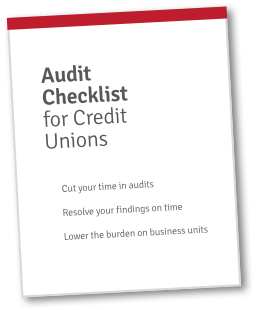At Redboard, we help credit unions organize, streamline, and even automate their audit processes. Over the years, we’ve developed a framework in which to conduct audits. It’s simple, repeatable, scalable, and most importantly, it works.
We call this framework our Findings Accountability Framework. In fact, we host regular master classes on the subject to help credit unions manage their own audits—and cut administrative time in half.
Simply click on the widget below to join our next session, where we’ll dive deep into the topic of this blog. For now, you can read this overview of one part of that class, which is the role of structure in audits, findings, and keeping things on track.
Free Webinar
Does your credit union ever struggle to resolve findings on time? Do you ever find any outliers, inconsistent answers, or things that make you raise an eyebrow?
In a perfect world, all audit findings would be resolved on time, as expected—reliably, and with no surprises. But the real world is often a little messier and less predictable… if you don’t have structure, that is.
Structure is foundational to successful, repeatable audits. And, when it comes to resolving findings, structure ensures that everyone knows what must be done, when, and by whom, so that nothing falls through the cracks and goes unresolved.
Structure determines performance. In fact, structure is more important than employee skill when it comes to audits. Even if your audit team is extremely competent, they’ll never truly realize their potential unless they’re properly supported through structure.
Researchers Bob Anderson and Bill Adams suggest that activity, structure, and employee skill are like a car race. The audit is the course, the structure is the vehicle, and the employee is the driver. If the object is to complete the course in a reasonable time, then a skilled driver must still be properly supported by their car in order to succeed. If that car is a Prius instead of a Porsche, the skill of the driver doesn’t matter—they can put the pedal to the metal and they’ll still fall behind.
So, how can credit unions create the right structure for their audits?
Creating Structure in Audits
Before we get too far ahead, let’s address one thing:
All credit union audit programs have structure. But remember, it might not be the right structure. There are a few signs of ineffective structure. If any of these questions sound familiar, your structure might need a tune-up:
- What’s the status of this item?
- Who’s working on this?
- What answers did we provide? How about last year?
- When is this due?
- Why was this late?
Or, if you haven’t heard those questions, you may have seen the effects of inadequate structure:
- Can’t address everything you need to
- Business units/departments are frustrated
- Less confidence about audit performance
- Hindered credit union growth
- The board or regulators want more
If any of the above strikes close to home, then it may be time to look at optimizing your audit structure. Here’s where your credit union can start:
First, classify all findings into “workflow stages.” Is it a draft? Management response? Remediation? Closed? Anyone should know the status of the finding at a glance.
Second, keep track of due dates. You should know two due dates, actually. First, what is your management response due date? Then, what is the remediation due date?
Third, what is the “data model”? This is your opportunity to gather and track fields of information for each finding. Simply put, this is all the information about the finding itself. There are three broad categories for findings data models:
- Descriptive data, which includes all the information about the finding, including the title, text, type, etc.
- Response data, including due dates, text responses, documentation, etc.
- Routing data, including workflow stage, who’s involved, etc.
If you keep track of all of this data in an accessible, central location, you’ll give yourself the tools and information needed to know what everything is, where it is, who’s working on it, and if it’s on track. Plus, you’ll have a well-documented trail.
What Does Structure Provide in Audits?
If you build a structure like the one outlined above, you should be able to rely on more clarity about the whole process (and better accountability, too)! Additionally, you should get:
- Clear expectations of who’s doing what and when
- Transparency about all audit activities
- Consistency both in processes and outcomes
- Reliable, on-time, and as-expected results
We invite you to come learn more about building more structure into your credit union’s audit process. Plus, you’ll learn more about two other key aspects of our Findings Accountability Framework: Business units and communication.
Redboard is an easy credit union audit management platform. It streamlines offsite and onsite strategies alike. Plus, its powerful automation capabilities and intuitive UX simplify tedious planning, tracking, and follow-up tasks. Our customers have reported audit and exam time savings of anywhere from 15–50%.
Subscribe to our blog to hear more, or request a short demo to see if Redboard would be a good fit for your credit union.


 Get FREE Access to the Audit Checklist for Credit Unions!
Get FREE Access to the Audit Checklist for Credit Unions!


